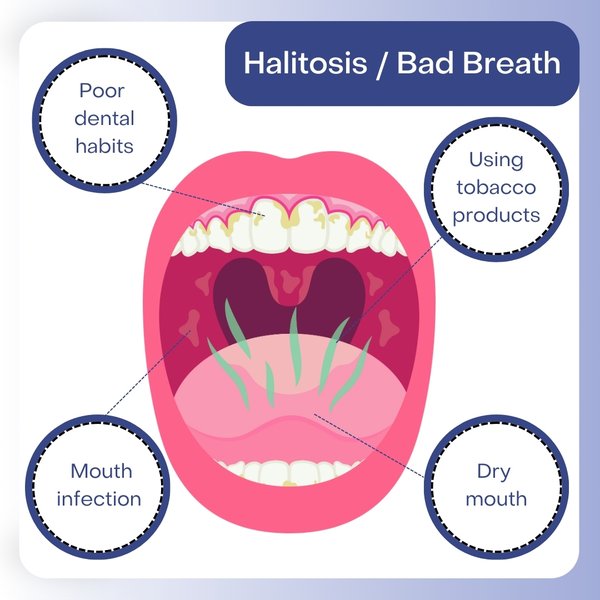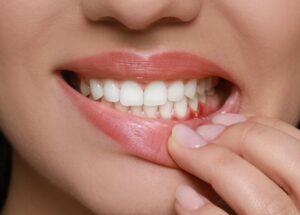- Halitosis is more than just an inconvenience; it’s a symptom. Often stemming from oral health issues, it demands attention, not just temporary fixes.
- Oral hygiene is paramount, but not the only factor. While good brushing and flossing are essential, dry mouth, gum disease, and even certain medical conditions can contribute to persistent bad breath.
- Addressing halitosis empowers social confidence. Understanding and treating the root causes can transform interactions and boost self-esteem.
Have you ever been in a conversation, and suddenly, you notice a subtle shift? Someone leaning away, a quick glance at their watch, maybe a polite offer of a mint. You might wonder, “Is it me? Is it my breath?” This common, often embarrassing issue is known as halitosis. It affects millions, not just after a garlic-filled meal, but persistently, signaling something deeper than just what you ate for lunch. This isn’t just about feeling awkward; it’s about your oral health, and yes, your social life too.
The Silent Social Killer: What is Halitosis ?
Halitosis, or chronic bad breath, is not merely about temporary odors. Instead, it’s a persistent condition. Unlike the transient smell from strong foods, halitosis lingers. It’s a real problem, impacting nearly one in three people. In fact, imagine that. It’s not just an annoyance; rather, it’s a social barrier. It creates distance , literally. People notice. Consequently, it can undermine your confidence, making even simple conversations feel like a challenge. You feel shy. You retreat. Ultimately, it’s a silent killer of social ease.

The Microbial Culprits: How Halitosis Forms
At its core, halitosis often originates in your mouth. To put it simply, your mouth is a bustling city of microorganisms. Among these, there are tiny, sulfur-producing bacteria. These bacteria feast on food particles, dead cells, and protein residues. As they do, they break down these substances and release volatile sulfur compounds (VSCs), which are the primary culprits behind that unpleasant odor. Consequently, these compounds are what make your breath smell, well, bad. It’s a natural process, but when it accelerates, that’s halitosis.
The Tongue's Role: A Bacterial Hotspot
One of the most common places for these bacteria to thrive is on the back of your tongue. The tongue’s rough surface provides an ideal environment for bacteria and dead cells to accumulate, forming a “coating.” This coated tongue can be a significant source of bad breath. It’s often overlooked. But it’s a major factor.

Beyond the Mouth: Other Contributors to Halitosis
While most halitosis cases are oral in origin, other factors can play a role, making the problem more complex. It’s not always just about what’s in your mouth.
Dry Mouth (Xerostomia): A Breeding Ground for Odor
Saliva is your mouth’s natural cleanser. It washes away food particles and bacteria. But when you don’t produce enough saliva , a condition known as dry mouth or xerostomia , your mouth loses this protective mechanism. This happens due to various factors, including certain medications, stress, dehydration, or even medical conditions. As a result, a dry mouth means more bacteria, which means more bad breath. Simple as that.
Gum Disease (Periodontitis): A Deeper Problem
Inflammation and infection of the gums, known as gingivitis or periodontitis, create pockets around the teeth where, unfortunately, bacteria can accumulate and multiply, hidden from brushing. Over time, these bacteria release toxins and VSCs, leading to a persistent and often more severe form of halitosis. Therefore, if you have gum disease, treating it is crucial for both your oral health and your breath.
Systemic Conditions: Less Common, But Possible
In rarer instances, halitosis can be a symptom of underlying systemic health issues. Conditions like sinus infections, tonsil stones, respiratory tract infections, diabetes, liver or kidney disease, and even certain cancers can manifest as bad breath. This is why a comprehensive approach, sometimes involving a medical doctor, is essential if oral causes are ruled out.

The Silent Social Killer: What is Halitosis?
The good news? Halitosis is often treatable. You don’t have to live with it. The key is understanding the cause and then addressing it directly. Forget the temporary fixes, the endless mints, the chewing gum. They mask; they don’t solve.
Your First Line of Defense: Oral Hygiene Excellence
The most common and effective solution for halitosis lies in diligent oral hygiene. This is your foundation. No shortcuts.
Brush and Floss Religiously
Brush your teeth at least twice a day, for two minutes each time, using fluoride toothpaste. In addition, don’t forget to floss daily. Flossing removes food particles and plaque from between your teeth and under the gumline—places your toothbrush can’t reach. As a result, this eliminates many of the hiding spots for odor-producing bacteria.
The Importance of Tongue Cleaning
This is a game-changer. Remember that bacterial coating on your tongue? A tongue scraper or even your toothbrush can effectively remove it. Start from the back of your tongue and gently scrape forward several times. You’ll see the difference. You’ll feel the difference. It’s effective. Jack, in one of our stories, found this simple step transformative.
Rinse and Hydrate for Success
An antibacterial mouthwash can help reduce bacteria in your mouth, but it’s a supplement, not a replacement for brushing and flossing. And drink plenty of water throughout the day. Staying hydrated stimulates saliva production, keeping your mouth moist and less hospitable to bacteria.
When to Seek Professional Help
If consistent oral hygiene doesn’t resolve your halitosis, it’s time to consult a professional. A dentist is your first stop.
Dental Check-ups: More Than Just Cleanings
Regular dental check-ups (every six months) are vital. Your dentist can identify and treat underlying oral issues like gum disease, cavities, or old fillings that might be trapping bacteria. Professional cleanings remove plaque and tartar that you can’t get rid of at home. They catch things early.
Beyond the Dentist: When a Doctor is Needed
If your dentist rules out oral causes, they might refer you to a medical doctor. This could indicate a non-oral source for your bad breath, such as a sinus infection, gastric issues, or other systemic conditions. It’s rare, but it happens. Getting a diagnosis is the first step to effective treatment.
Navigating the Social Aspect of Halitosis
Halitosis isn’t just a medical issue; it’s a social one. It can affect relationships, careers, and overall self-esteem. Knowing how to approach it, both personally and when dealing with others, is key..
The "Jack" Story: Personal Impact
Let me tell you a quick story. There was this guy, let’s call him Jack. Jack had halitosis for years. Not the occasional morning breath kind, but the chronic one that lingers. His partner noticed it first. “Hey, babe, your breath smells funky,” she said one evening, trying to be polite. Jack felt embarrassed. Who wouldn’t? This personal experience highlights the real emotional toll of halitosis. It affects intimacy, friendships, and professional interactions. No one wants to be “that person.”
How to Address Bad Breath in Others (Politically, of Course)
It’s a delicate situation. So how do you tell someone they have bad breath without offending them? In these cases, diplomacy is key. Sometimes, a gentle, indirect hint works, like offering a mint. On other occasions, a private, caring conversation is needed. Instead of blaming, focus on concern for their health, rather than judgment. “I care about you, and I’ve noticed your breath has been a bit off lately. Have you talked to your dentist about it?” It’s tough. Nevertheless, sometimes a direct but gentle hint is needed.
A Deep Dive into Halitosis Myths with Dr. Bernard J. Hennessy
To further enrich our understanding of halitosis, it’s beneficial to hear from experts. The video below features Dr. Bernard J. Hennessy, DDS, a Doctor of Dental Surgery at Texas A&M University School of Dentistry, discussing common myths surrounding bad breath. This perspective from a dental professional provides valuable insights into what truly causes halitosis and dispels common misconceptions, reinforcing the importance of evidence-based approaches to treatment and prevention.






